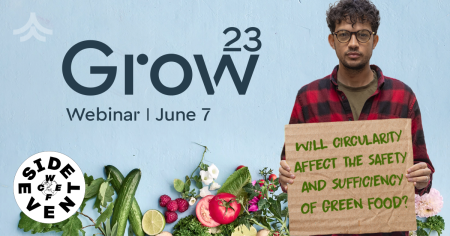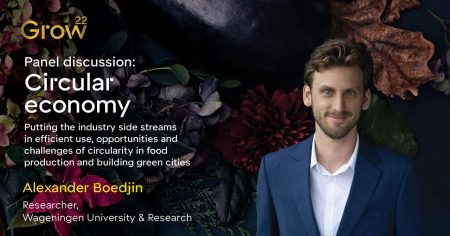Shaping the circular future for greenhouse horticulture
During the Grow22 festival the panel discussion “Circular economy” took place, in which Alexander Boedijn kicked off with his introduction to the topic. As a researcher at the Wageningen University & Research he focuses on the transition towards a circular greenhouse sector. A topic which is becoming increasingly more in focus since a couple of years.

This year, during the Grow23 festival, we will continue the discussion and look at steps already taken in Circularity in Food Production.
First step
Many businesses are already familiar with recycling as a way to reduce waste in horticulture. This is a first step towards the circular economy, however there are opportunities to enable better reuse of waste streams. Many of these streams are disposed of in a way which makes reusing them almost impossible. However the resources needed for the industry are depleting natural reserves. Therefore in the Netherlands the target for 2030 is set to reduce 50% of the use of natural resources. This will be a challenge for the horticulture industry which depends on materials like phosphate, basalt and oil.
“The fact that resources remain on planet earth does not mean we can easily reuse them”
Going from grey to green

To make the next steps towards circularity more clear Alexander introduces the supporting visual of moving from the “grey circle” to the “green circle”: Going from taking resources to reducing the need for these raw materials, by reusing what is in the green circle. This can be done, for instance, by tapping into other businesses’ waste flows, which can be valuable for the greenhouse horticulture industry. He also shares insightful flowcharts for various material flows in the tomato growing business as well as roses and phalaenopsis (orchids). With these analyses he can better analyze where the waste streams for different crops are, and therefore spot the opportunities to reduce the most per industry sector.
Circular creativity
There is a lot of work to do to, but there are also good examples of where the industry is already taking the first steps towards a circular economy in the horticulture industry, by being creative. For example the recirculation of fertigation water in the Netherlands is already happening for decades. The goal here is to be emission free by 2027, where all of the rainwater that is used will be almost 100% reused. Thereby, next to saving water, it is also minimizing the loss of fertilizers and plant protection products. Another good example Alexander mentions is to produce a nitrate fertilizer based on manure, but still suitable for the high tech irrigation systems in the greenhouses. And sometimes it is about a different way of thinking about the business case of what you sell. The last example shared is about orchids as a service, saving raw material input compared to traditional business models.
Interested to know the rest of the story? Watch the full panel discussion video, including the valuable contributions of William Neale, Dr Ilmari Absetz, Gerard Sikes and Jussi Kankainen.